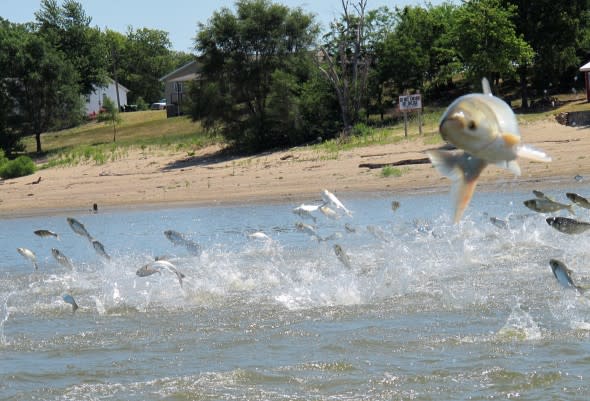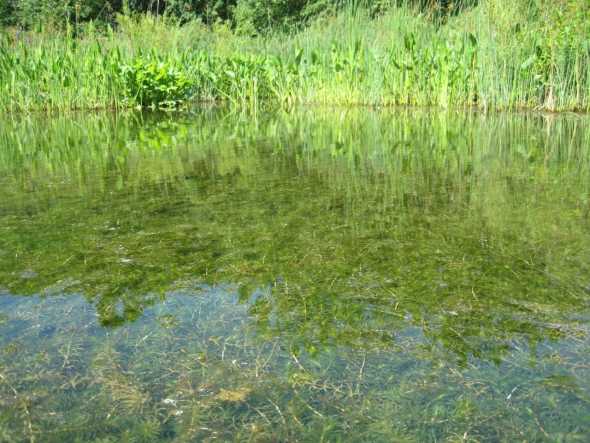Invasive aquatic species in US wreak havoc on ecosystems, cost hundreds of millions of dollars
Invasive aquatic species in the United States have caused not just ecological damage, but financial damage as well. In some cases, they can also affect the health of humans.
With climate change and warming waters, Cleveland Metroparks fishery biologist Mike Durkalec said there's a possibility of more surviving in regions where they normally couldn't.
An invasive species currently making its way up the Mississippi River is the Asian carp. These fish can cause trouble to the ecosystem and anglers alike not just by undermining the food chain, but they can be a danger to fish as well. If startled by something like a motorboat, they tend to jump. In some cases, they've been known to break bones of people on a quick-moving boat, according to Durkalec.

Photo shows an Asian carp, jolted by an electric current from a research boat, jumping from the Illinois River near Havana, Ill on June 13, 2012. (AP Photo/John Flesher)
Other troublesome examples are zebra mussels and quagga mussels, which hitchhiked their way from Ukraine and Russia to the Great Lakes through ship ballasts according to the U.S. Geographical Survey. The first sightings of the two mussels in the lakes were around the late 1980s and early 1990s. The mussels don't jump out of the water to collide with unsuspecting anglers, but they do contribute to the algae bloom problem of Lake Erie.
Durkalec makes it clear that the species aren't the cause of the algae blooms, but they're filtering out plankton and leaving behind the bacteria that is "the basis of these harmful algae blooms."
"That's another reason a lot of people should care about things like this. They can have trickle-down effects that can affect, in this case, lots and lots of people and cost lots and lots of money to address," said Durkalec.
Mark Warman is a part of a project at Cleveland Metroparks that surveys internally and manages the population of hydrilla, an invasive aquatic plant, in their region. The project extends to "everything that drains into Lake Erie in Ohio," and it partners with public and private land owners to search their properties and bodies of water for hydrilla and other invasive hydraulic plants according to Warman.
"It's widely regarded as one of the most problematic aquatic plants. Because it grows so quickly, it forms dense mass," Warman said. He notes that in some cases people have recorded it growing up to an inch a day.
The plant can interfere with recreational activities, potentially jamming boat motors and causing problems for anglers. Through this program, Warman and others hope to save money in prevention in the future.

Hydrilla is a highly problematic invasive aquatic plant. (Photo/Jennifer Hillmer)
Currently, a $350,000 grant is funding the hydrilla project to keep it from extending its reach according to Durkalec. That's a relatively small amount compared to the amount spent in Florida in 2007.
In the 2016-2017 fiscal year, public and federal funding spent about $23.6 million to control invasive aquatic plants. The cost of controlling hydrilla took about 63 percent of that. The reasoning behind putting so much money into fighting against aquatic plants was the value of fishing activity and other forms of recreation that lakes and other bodies of water could have.
In a model created in 2007 to predict the costs and benefits of invasive species control using 13 of the 454 public lakes and rivers in Florida, the bodies of water held an estimated value of $64.78 million per year from fishing activity alone, and the "steady-state net benefit of the status quo control strategy is $59.95 million."
Lapsing in their efforts to hold off the spread of the hydrilla would end up costing more than what the funds are already paying. According to the same model, a lapse of that time would cause a 20.67 percent decrease in recreation and cost twice the amount of costs in long-term control.
This isn't the only invasive species that is costing these programs money. Durkalec estimates that from the time that the first Europeans arrived in America, the number of invasive aquatic species is approaching nearly 200 in the Great Lakes region alone.
From 2010 to 2017, the Great Lakes Restoration Initiative alone has spent about $443.3 million for projects on containing and preventing invasive species in the Great Lakes. This is just one of the many organizations that is making an effort to stop invasive species in the Great Lakes.
"The point is that the price tag is staggering," said Durkalec.
Climate change and warming waters may have a contributing factor in the spreading and growing of invasive species as well.
Durkalec explains a biological principle called the latitudinal diversity gradient, where biodiversity generally decreases moving away from the equator and toward the poles. As the climate warms, that latitudinal line moves higher, said Durkalec.
"Quite reasonably, you can deduce that it's going to open a door not only for new species, but because it's opening a door for more southern species where there's greater biodiversity," said Durkalec. "It's reasonable to imagine it's opening a door for a greater number of species as well."
It isn't just newly introduced species moving north that can cause problems. Asian carp, more specifically bighead and silver carp, have been steadily creeping up the Mississippi River toward the Great Lakes.
"The southern edge of the Great Lakes is at the northern edge of their native range, so it is fathomable to think as climate change warms... that it'll open a door even more so for these two Asian carp species to move farther north," said Durkalec.
Biologists aren't sure what could happen if the carp find their way into the Great Lakes, just that the results could be devastating.
Another source of invasive species comes from within our homes.
"This varies state to state, but many exotic, non-native and invasive plants are still available for water gardens or aquariums," said Warman. "One message that Cleveland Metro Parks continues to push and educate our audience about is please never release aquariums or pets, wildlife of any sort out into the natural areas."
Even fish as simple as goldfish can hurt the ecosystem of a body of water. According to the United States Geological Survey, goldfish have invaded every state in the U.S. as well as Washington D.C., and Puerto Rico.
Warman notes that one thing that they're seeing as the climate changes is invasive species of tropical origins surviving in region where they shouldn't. One thing that they're finding is Brazilian water weeds, which are commonly used in aquariums.
"We've got multi-year infestations, and evidence that some of these more tropical plants are adapting to our climate up in the northern latitude," said Warman. "We're concerned about more aquarium plants being able to either survive in these more hospitable, warmer climates, or just growing more rapidly if they're released in our park district and in our region."
Durkalec cand Warman suggest an alternative to releasing pets and aquatic plants into the wild, instead re-homing them, or finding a rescue organization that can accept wildlife in the worse-case scenario. For getting rid of aquatic plants, Warman suggests throwing them in the trash or a place for them to dry out, like a compost bin.
Durkalec suggested another alternative to releasing a pet fish into nature.
"An interesting (method) that may not be palatable with some people -- some of the non-native fish species people keep in aquariums, if they get too big, they are edible," said Durkalec.
He gave the example of pacu fish as an edible aquarium fish, which they routinely show up in the lakes and ponds of Cleveland Metro Park.
"You could eat your pet. Talk about things getting muddled!" said Durkalec.
